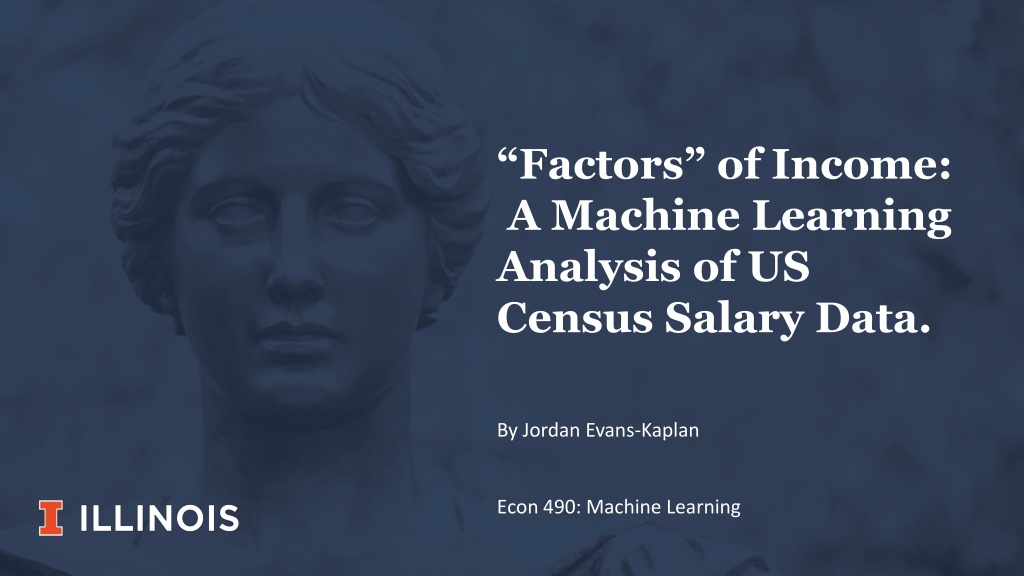Factors of Income: A Machine Learning Analysis
A machine learning analysis of US Census salary data aiming to predict income levels based on critical variables like marital status, age, and capital gains. The study explores XGBoost as a powerful algorithm for predicting annual income thresholds, with potential applications in analyzing the economic health of populations. Literature reviews on related data mining works are discussed, highlighting the importance of accurate classification methods.
Download Presentation

Please find below an Image/Link to download the presentation.
The content on the website is provided AS IS for your information and personal use only. It may not be sold, licensed, or shared on other websites without obtaining consent from the author. Download presentation by click this link. If you encounter any issues during the download, it is possible that the publisher has removed the file from their server.
E N D
Presentation Transcript
Factors of Income: A Machine Learning Analysis of US Census Salary Data. By Jordan Evans-Kaplan Econ 490: Machine Learning
Motivation Studying Census data allows economists to grasp the driving forces behind Income. My goal was to regress two factor income levels: <=$50K and >$50K and identify the most critical variables to predict annual income thresholds. Some of the most effective variables included were: Marital Status Age Capital Gains The future applications of this work include generalizing economic health in regions without income data, but where the predictor variables are available. This allows data scientists to analyze the economic health of entire populations, rather than just one component. Potential downside: High computing/processing cost due to large datasets.
Literature Review Kohavi, "Scaling Up the Accuracy of Naive-Bayes Classifiers: A Decision-Tree Hybrid.", Proceedings of the Second International Conference on Knowledge Discovery and Data Mining. Landmark paper which began the study into Census Income classification. Chakrabarty, A Statistical Approach to Adult Census Income Level Prediction. Recent paper which set the current record with this dataset at 88.16%.
What is XGBoost? Stands for: eXtreme Gradient Boosting. XGBoost is a powerful iterative learning algorithm based on gradient boosting. Robust and highly versatile, with custom objective loss function compatibility.
How does XGBoost work? Tree-Based Boosting algorithm. 4 Critical Parameters for Tuning: : ETA or Learning Rate max_depth: Controls the height of the tree via splits. : Minimum required loss for the model to justify a split. : L2 (Ridge) regularization on variable weights.
Why use Xgboost? All of the advantages of gradient boosting, plus more. Frequent Kaggle data competition champion. Utilizes CPU Parallel Processing by default. Two main reasons for use: 1. Low Runtime 2. High Model Performance
Tuning XGBoost In order to produce the optimal XGBoost model, a grid-search method was employed against a hyper-grid of possible parameters. After tuning the model against these possibilities, the following graph was produced: Figure shows the accuracy in each of the 9 possible grids. Highest accuracy was obtained in the bottom right quadrant, where the value of Gamma is 1, and Max Tree Depth is 3. The blue line represents the shrinkage rate of 1/3, otherwise called ETA.
Model Results: Model Results:
Conclusion: XGBoost Accuracy before tuning: 84.66% Accuracy : 0.8466 Tuned XGBoost Accuracy: 87.09460% Accuracy: 0.870946 Models such as these allow for robust income classification, and identify key variables associated with higher income brackets.
Thank You! Special appreciation goes out to: Econ 490 Machine Learning Staff: Nazanin Khazra Abdollah Farhoodi Personal Contact Information: Jordan Evans-Kaplan Email: Evanska2@Illinois.edu Designer of XGBoost: Tianqi Chen























